E1144 Certificate III: Individual Support Module 3 - Working Safely
VerifiedAdded on 2020/03/04
|21
|5859
|571
Homework Assignment
AI Summary
This homework assignment, completed by a student, addresses crucial aspects of safe work practices in the aged care industry, specifically focusing on manual handling and infection control. The assignment is divided into two parts. Part A examines manual handling hazards through a risk assessment example, requiring the student to conduct their own risk assessment for a common community service task, identify potential hazards, and explain reporting procedures. The student must also categorize the risk level using a matrix, justify their choice, and identify best practices for posture to reduce injury risks, referencing the Manual Handling Code of Practice for New South Wales. Part B focuses on infection control, prompting the student to identify infection risks, list standard precautions, and discuss waste disposal and disinfectant protocols. The assignment aims to assess the student's understanding of safe practices, risk assessment, and adherence to relevant codes of practice, providing a comprehensive overview of essential safety considerations for support workers in aged care settings.
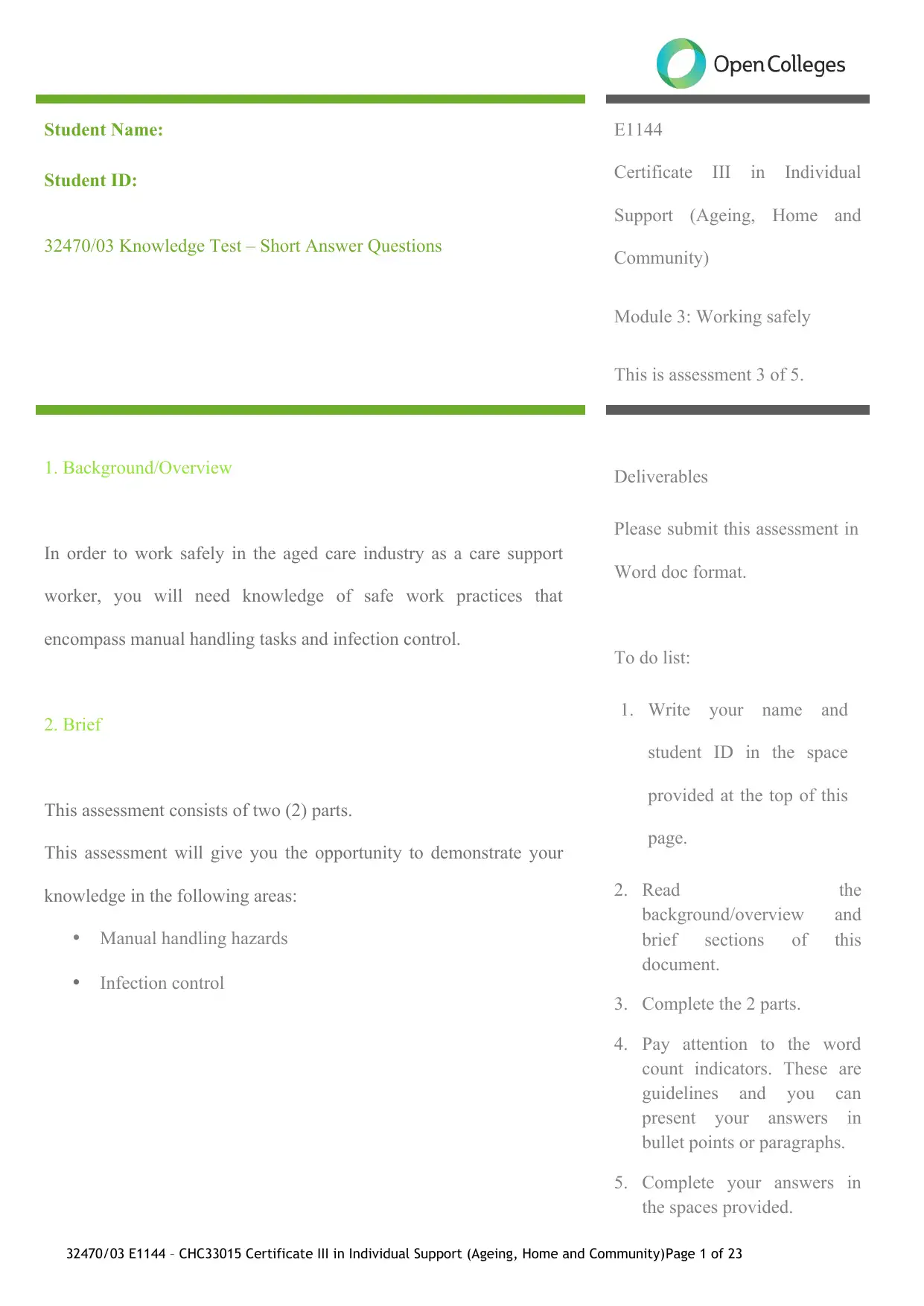
32470/03 E1144 – CHC33015 Certificate III in Individual Support (Ageing, Home and Community)Page 1 of 23
Student Name:
Student ID:
32470/03 Knowledge Test – Short Answer Questions
E1144
Certificate III in Individual
Support (Ageing, Home and
Community)
Module 3: Working safely
This is assessment 3 of 5.
1. Background/Overview
In order to work safely in the aged care industry as a care support
worker, you will need knowledge of safe work practices that
encompass manual handling tasks and infection control.
2. Brief
This assessment consists of two (2) parts.
This assessment will give you the opportunity to demonstrate your
knowledge in the following areas:
Manual handling hazards
Infection control
Deliverables
Please submit this assessment in
Word doc format.
To do list:
1. Write your name and
student ID in the space
provided at the top of this
page.
2. Read the
background/overview and
brief sections of this
document.
3. Complete the 2 parts.
4. Pay attention to the word
count indicators. These are
guidelines and you can
present your answers in
bullet points or paragraphs.
5. Complete your answers in
the spaces provided.
Student Name:
Student ID:
32470/03 Knowledge Test – Short Answer Questions
E1144
Certificate III in Individual
Support (Ageing, Home and
Community)
Module 3: Working safely
This is assessment 3 of 5.
1. Background/Overview
In order to work safely in the aged care industry as a care support
worker, you will need knowledge of safe work practices that
encompass manual handling tasks and infection control.
2. Brief
This assessment consists of two (2) parts.
This assessment will give you the opportunity to demonstrate your
knowledge in the following areas:
Manual handling hazards
Infection control
Deliverables
Please submit this assessment in
Word doc format.
To do list:
1. Write your name and
student ID in the space
provided at the top of this
page.
2. Read the
background/overview and
brief sections of this
document.
3. Complete the 2 parts.
4. Pay attention to the word
count indicators. These are
guidelines and you can
present your answers in
bullet points or paragraphs.
5. Complete your answers in
the spaces provided.
Paraphrase This Document
Need a fresh take? Get an instant paraphrase of this document with our AI Paraphraser
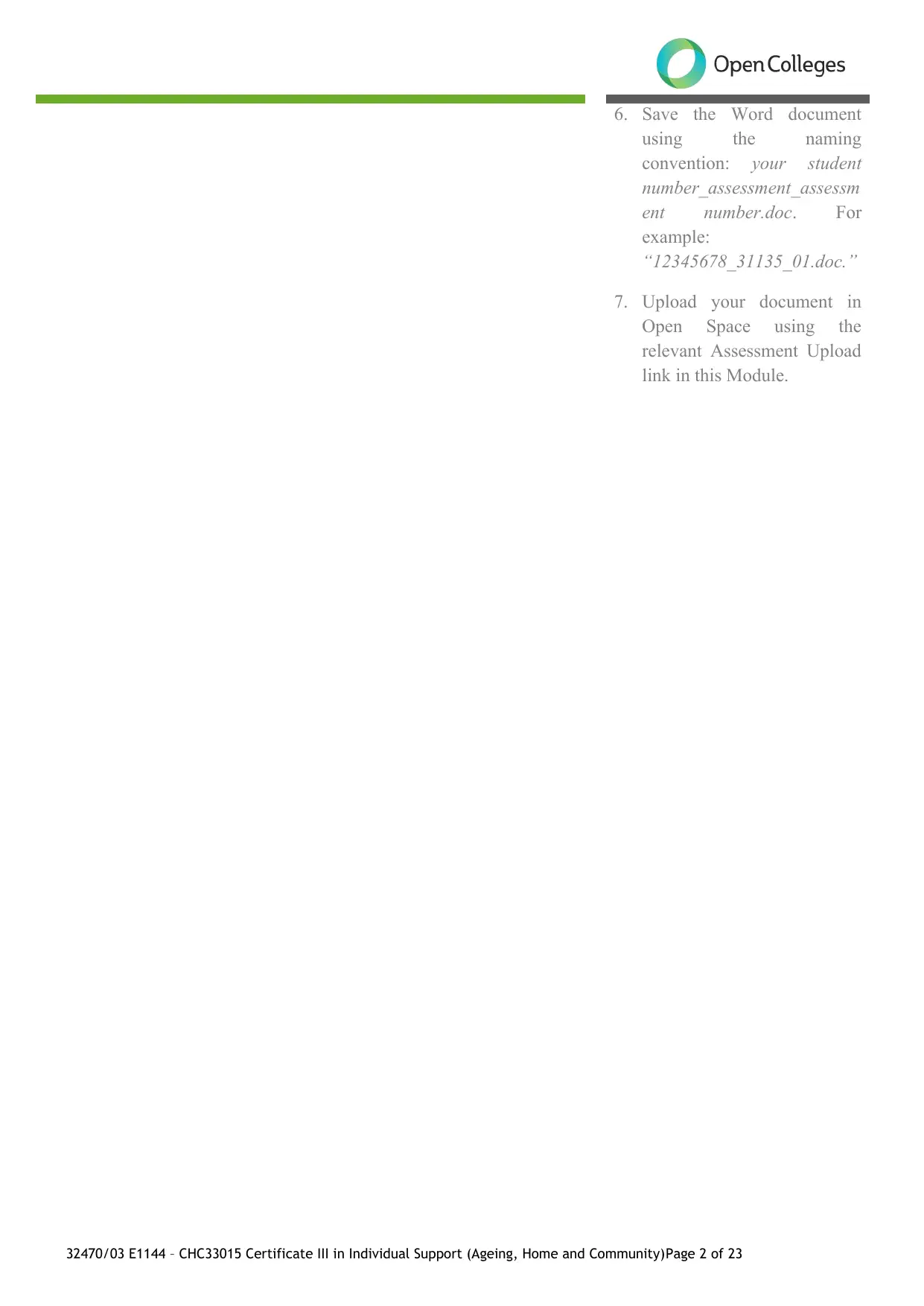
32470/03 E1144 – CHC33015 Certificate III in Individual Support (Ageing, Home and Community)Page 2 of 23
6. Save the Word document
using the naming
convention: your student
number_assessment_assessm
ent number.doc. For
example:
“12345678_31135_01.doc.”
7. Upload your document in
Open Space using the
relevant Assessment Upload
link in this Module.
6. Save the Word document
using the naming
convention: your student
number_assessment_assessm
ent number.doc. For
example:
“12345678_31135_01.doc.”
7. Upload your document in
Open Space using the
relevant Assessment Upload
link in this Module.
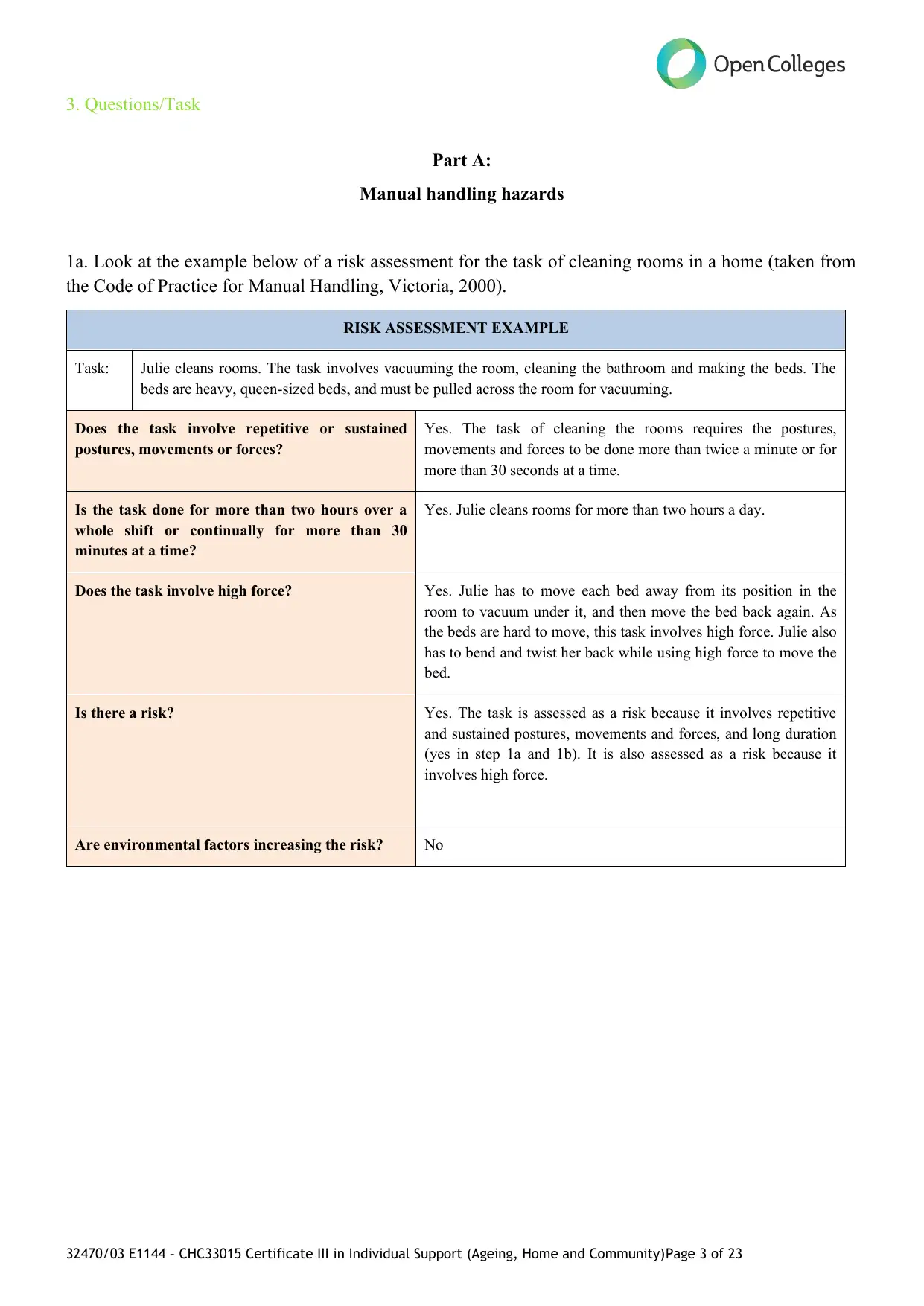
3. Questions/Task
Part A:
Manual handling hazards
1a. Look at the example below of a risk assessment for the task of cleaning rooms in a home (taken from
the Code of Practice for Manual Handling, Victoria, 2000).
RISK ASSESSMENT EXAMPLE
Task: Julie cleans rooms. The task involves vacuuming the room, cleaning the bathroom and making the beds. The
beds are heavy, queen-sized beds, and must be pulled across the room for vacuuming.
Does the task involve repetitive or sustained
postures, movements or forces?
Yes. The task of cleaning the rooms requires the postures,
movements and forces to be done more than twice a minute or for
more than 30 seconds at a time.
Is the task done for more than two hours over a
whole shift or continually for more than 30
minutes at a time?
Yes. Julie cleans rooms for more than two hours a day.
Does the task involve high force? Yes. Julie has to move each bed away from its position in the
room to vacuum under it, and then move the bed back again. As
the beds are hard to move, this task involves high force. Julie also
has to bend and twist her back while using high force to move the
bed.
Is there a risk? Yes. The task is assessed as a risk because it involves repetitive
and sustained postures, movements and forces, and long duration
(yes in step 1a and 1b). It is also assessed as a risk because it
involves high force.
Are environmental factors increasing the risk? No
32470/03 E1144 – CHC33015 Certificate III in Individual Support (Ageing, Home and Community)Page 3 of 23
Part A:
Manual handling hazards
1a. Look at the example below of a risk assessment for the task of cleaning rooms in a home (taken from
the Code of Practice for Manual Handling, Victoria, 2000).
RISK ASSESSMENT EXAMPLE
Task: Julie cleans rooms. The task involves vacuuming the room, cleaning the bathroom and making the beds. The
beds are heavy, queen-sized beds, and must be pulled across the room for vacuuming.
Does the task involve repetitive or sustained
postures, movements or forces?
Yes. The task of cleaning the rooms requires the postures,
movements and forces to be done more than twice a minute or for
more than 30 seconds at a time.
Is the task done for more than two hours over a
whole shift or continually for more than 30
minutes at a time?
Yes. Julie cleans rooms for more than two hours a day.
Does the task involve high force? Yes. Julie has to move each bed away from its position in the
room to vacuum under it, and then move the bed back again. As
the beds are hard to move, this task involves high force. Julie also
has to bend and twist her back while using high force to move the
bed.
Is there a risk? Yes. The task is assessed as a risk because it involves repetitive
and sustained postures, movements and forces, and long duration
(yes in step 1a and 1b). It is also assessed as a risk because it
involves high force.
Are environmental factors increasing the risk? No
32470/03 E1144 – CHC33015 Certificate III in Individual Support (Ageing, Home and Community)Page 3 of 23
⊘ This is a preview!⊘
Do you want full access?
Subscribe today to unlock all pages.

Trusted by 1+ million students worldwide
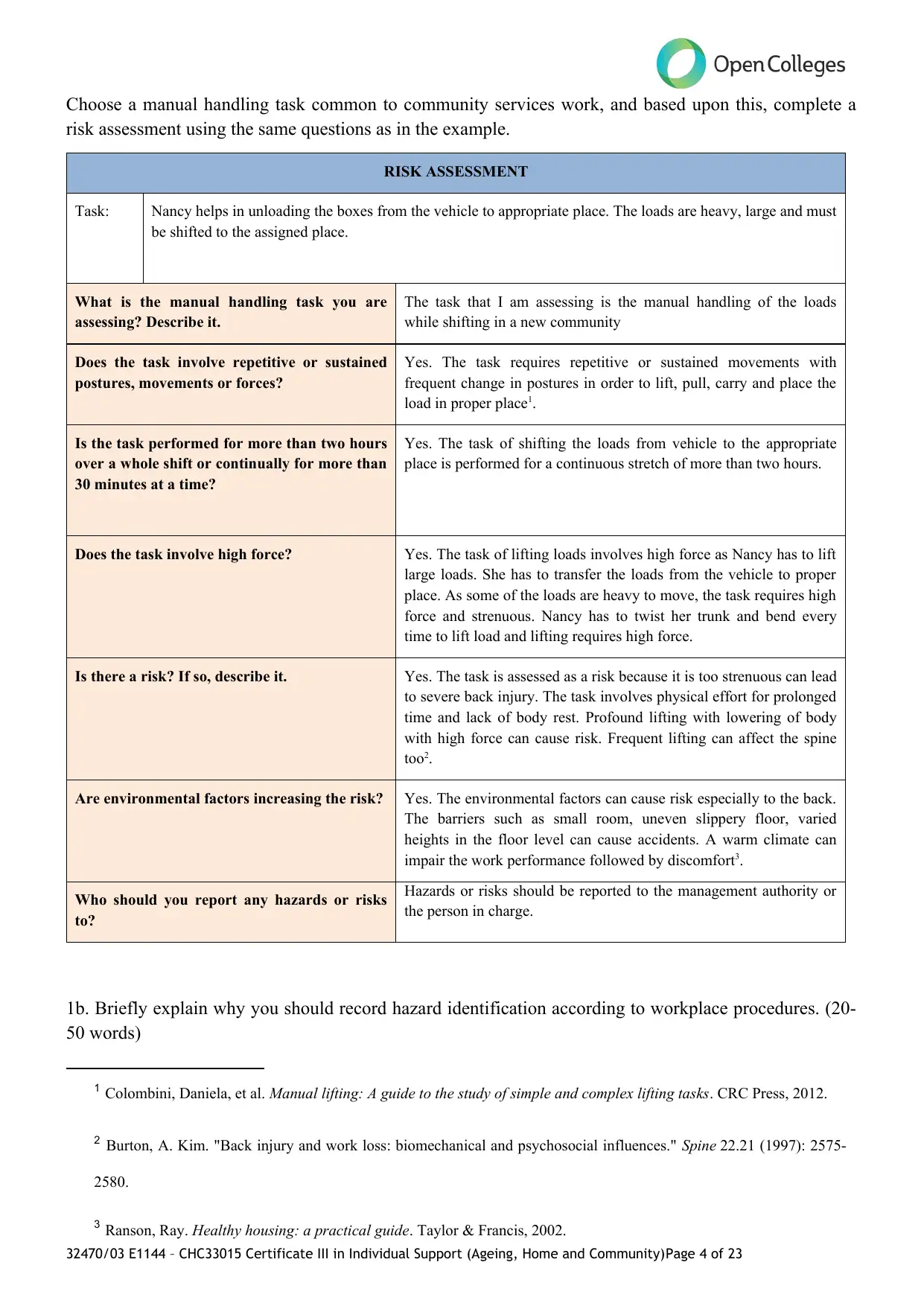
Choose a manual handling task common to community services work, and based upon this, complete a
risk assessment using the same questions as in the example.
RISK ASSESSMENT
Task: Nancy helps in unloading the boxes from the vehicle to appropriate place. The loads are heavy, large and must
be shifted to the assigned place.
What is the manual handling task you are
assessing? Describe it.
The task that I am assessing is the manual handling of the loads
while shifting in a new community
Does the task involve repetitive or sustained
postures, movements or forces?
Yes. The task requires repetitive or sustained movements with
frequent change in postures in order to lift, pull, carry and place the
load in proper place1.
Is the task performed for more than two hours
over a whole shift or continually for more than
30 minutes at a time?
Yes. The task of shifting the loads from vehicle to the appropriate
place is performed for a continuous stretch of more than two hours.
Does the task involve high force? Yes. The task of lifting loads involves high force as Nancy has to lift
large loads. She has to transfer the loads from the vehicle to proper
place. As some of the loads are heavy to move, the task requires high
force and strenuous. Nancy has to twist her trunk and bend every
time to lift load and lifting requires high force.
Is there a risk? If so, describe it. Yes. The task is assessed as a risk because it is too strenuous can lead
to severe back injury. The task involves physical effort for prolonged
time and lack of body rest. Profound lifting with lowering of body
with high force can cause risk. Frequent lifting can affect the spine
too2.
Are environmental factors increasing the risk? Yes. The environmental factors can cause risk especially to the back.
The barriers such as small room, uneven slippery floor, varied
heights in the floor level can cause accidents. A warm climate can
impair the work performance followed by discomfort3.
Who should you report any hazards or risks
to?
Hazards or risks should be reported to the management authority or
the person in charge.
1b. Briefly explain why you should record hazard identification according to workplace procedures. (20-
50 words)
1 Colombini, Daniela, et al. Manual lifting: A guide to the study of simple and complex lifting tasks. CRC Press, 2012.
2 Burton, A. Kim. "Back injury and work loss: biomechanical and psychosocial influences." Spine 22.21 (1997): 2575-
2580.
3 Ranson, Ray. Healthy housing: a practical guide. Taylor & Francis, 2002.
32470/03 E1144 – CHC33015 Certificate III in Individual Support (Ageing, Home and Community)Page 4 of 23
risk assessment using the same questions as in the example.
RISK ASSESSMENT
Task: Nancy helps in unloading the boxes from the vehicle to appropriate place. The loads are heavy, large and must
be shifted to the assigned place.
What is the manual handling task you are
assessing? Describe it.
The task that I am assessing is the manual handling of the loads
while shifting in a new community
Does the task involve repetitive or sustained
postures, movements or forces?
Yes. The task requires repetitive or sustained movements with
frequent change in postures in order to lift, pull, carry and place the
load in proper place1.
Is the task performed for more than two hours
over a whole shift or continually for more than
30 minutes at a time?
Yes. The task of shifting the loads from vehicle to the appropriate
place is performed for a continuous stretch of more than two hours.
Does the task involve high force? Yes. The task of lifting loads involves high force as Nancy has to lift
large loads. She has to transfer the loads from the vehicle to proper
place. As some of the loads are heavy to move, the task requires high
force and strenuous. Nancy has to twist her trunk and bend every
time to lift load and lifting requires high force.
Is there a risk? If so, describe it. Yes. The task is assessed as a risk because it is too strenuous can lead
to severe back injury. The task involves physical effort for prolonged
time and lack of body rest. Profound lifting with lowering of body
with high force can cause risk. Frequent lifting can affect the spine
too2.
Are environmental factors increasing the risk? Yes. The environmental factors can cause risk especially to the back.
The barriers such as small room, uneven slippery floor, varied
heights in the floor level can cause accidents. A warm climate can
impair the work performance followed by discomfort3.
Who should you report any hazards or risks
to?
Hazards or risks should be reported to the management authority or
the person in charge.
1b. Briefly explain why you should record hazard identification according to workplace procedures. (20-
50 words)
1 Colombini, Daniela, et al. Manual lifting: A guide to the study of simple and complex lifting tasks. CRC Press, 2012.
2 Burton, A. Kim. "Back injury and work loss: biomechanical and psychosocial influences." Spine 22.21 (1997): 2575-
2580.
3 Ranson, Ray. Healthy housing: a practical guide. Taylor & Francis, 2002.
32470/03 E1144 – CHC33015 Certificate III in Individual Support (Ageing, Home and Community)Page 4 of 23
Paraphrase This Document
Need a fresh take? Get an instant paraphrase of this document with our AI Paraphraser

2a.
Below is an example of a typical risk assessment matrix. Decide whether the manual handling task you
have assessed in the question above is of low, moderate, high or extreme risk. Highlight where you think
the risk lies on the matrix (to highlight a word, you can make the word a different colour or apply a ‘Text
Highlight Color’ from the Microsoft Word icon options).
Consequences
1 -
Insignifica
nt
Dealt with
by in-house
first aid,
etc.
2 - Minor
Medical
help
needed.
Treatment
by medical
professiona
l/hospital
outpatient,
etc.
3 -
Moderate
Significant
non-
permanent
injury.
Overnight
hospitalisati
on
(inpatient).
4 - Major
Extensive
permanent
injury (eg.
loss of
finger/s).
Extended
hospitalisati
on.
5 -
Catastroph
ic
Death.
Permanent
disabling
injury (eg.
blindness,
loss of
hand/s,
quadriplegi
a).
Likelihood
A Almost
certain to
occur in most
circumstances
High (H) High (H) Extreme
(X)
Extreme
(X)
Extreme
(X)
B Likely to
occur
frequently
Moderate
(M) High (H) High (H) Extreme
(X)
Extreme
(X)
C Possible
and likely to
occur at some
time
Low (L) Moderate
(M) High (H) Extreme
(X)
Extreme
(X)
D Unlikely to
occur but
could happen
Low (L) Low (L) Moderate
(M)
High (H) Extreme
(X)
32470/03 E1144 – CHC33015 Certificate III in Individual Support (Ageing, Home and Community)Page 5 of 23
Answer: Recording the hazards is essential according to workplace in order to evaluate and
document the risk factors. The assessment should be done to reduce the risk factors by consulting
with the person or the team doing the work. The control measures suggested and likewise taken can
avoid or lessen the injury risk.
Below is an example of a typical risk assessment matrix. Decide whether the manual handling task you
have assessed in the question above is of low, moderate, high or extreme risk. Highlight where you think
the risk lies on the matrix (to highlight a word, you can make the word a different colour or apply a ‘Text
Highlight Color’ from the Microsoft Word icon options).
Consequences
1 -
Insignifica
nt
Dealt with
by in-house
first aid,
etc.
2 - Minor
Medical
help
needed.
Treatment
by medical
professiona
l/hospital
outpatient,
etc.
3 -
Moderate
Significant
non-
permanent
injury.
Overnight
hospitalisati
on
(inpatient).
4 - Major
Extensive
permanent
injury (eg.
loss of
finger/s).
Extended
hospitalisati
on.
5 -
Catastroph
ic
Death.
Permanent
disabling
injury (eg.
blindness,
loss of
hand/s,
quadriplegi
a).
Likelihood
A Almost
certain to
occur in most
circumstances
High (H) High (H) Extreme
(X)
Extreme
(X)
Extreme
(X)
B Likely to
occur
frequently
Moderate
(M) High (H) High (H) Extreme
(X)
Extreme
(X)
C Possible
and likely to
occur at some
time
Low (L) Moderate
(M) High (H) Extreme
(X)
Extreme
(X)
D Unlikely to
occur but
could happen
Low (L) Low (L) Moderate
(M)
High (H) Extreme
(X)
32470/03 E1144 – CHC33015 Certificate III in Individual Support (Ageing, Home and Community)Page 5 of 23
Answer: Recording the hazards is essential according to workplace in order to evaluate and
document the risk factors. The assessment should be done to reduce the risk factors by consulting
with the person or the team doing the work. The control measures suggested and likewise taken can
avoid or lessen the injury risk.
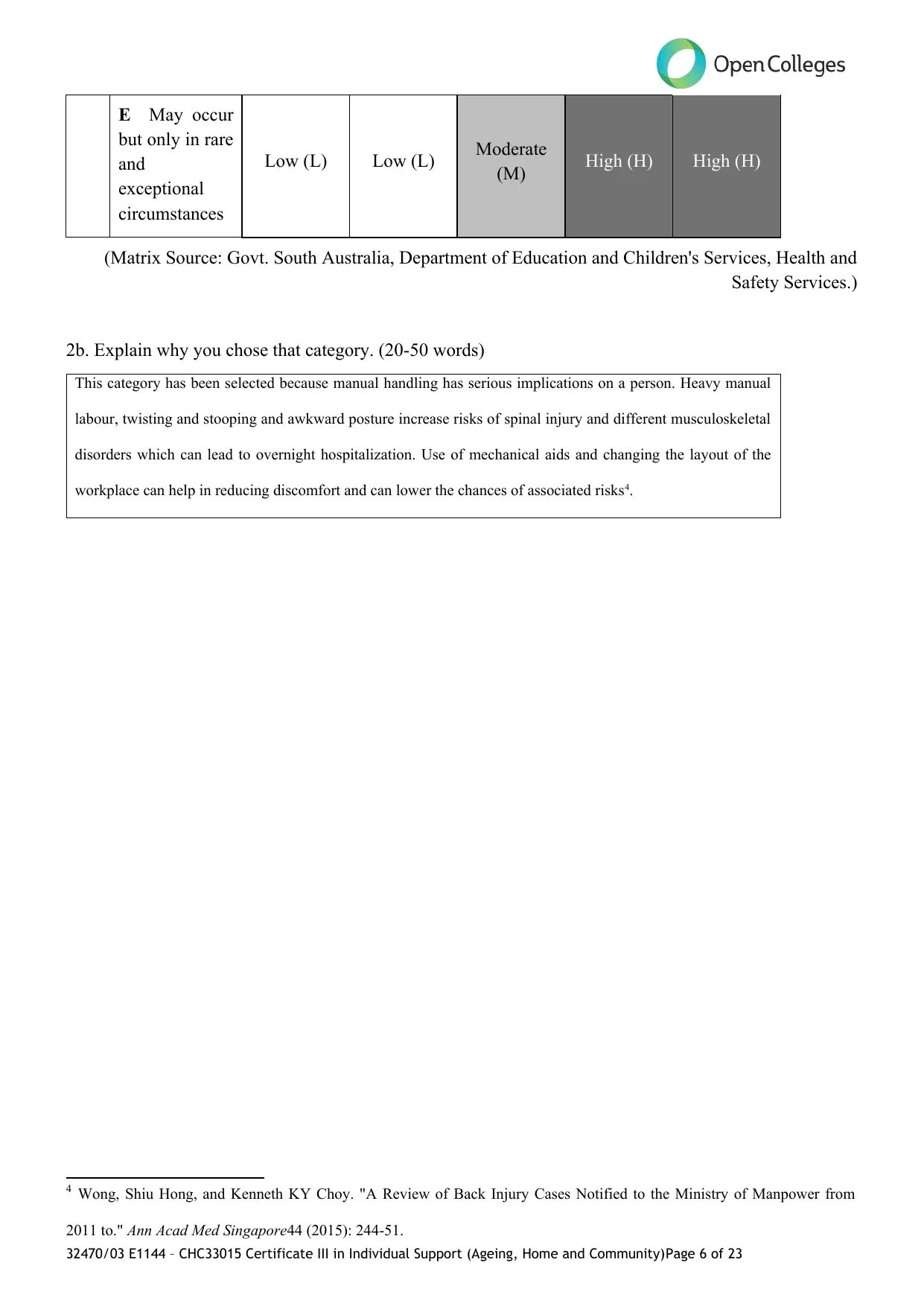
E May occur
but only in rare
and
exceptional
circumstances
Low (L) Low (L) Moderate
(M) High (H) High (H)
(Matrix Source: Govt. South Australia, Department of Education and Children's Services, Health and
Safety Services.)
2b. Explain why you chose that category. (20-50 words)
This category has been selected because manual handling has serious implications on a person. Heavy manual
labour, twisting and stooping and awkward posture increase risks of spinal injury and different musculoskeletal
disorders which can lead to overnight hospitalization. Use of mechanical aids and changing the layout of the
workplace can help in reducing discomfort and can lower the chances of associated risks4.
4 Wong, Shiu Hong, and Kenneth KY Choy. "A Review of Back Injury Cases Notified to the Ministry of Manpower from
2011 to." Ann Acad Med Singapore44 (2015): 244-51.
32470/03 E1144 – CHC33015 Certificate III in Individual Support (Ageing, Home and Community)Page 6 of 23
but only in rare
and
exceptional
circumstances
Low (L) Low (L) Moderate
(M) High (H) High (H)
(Matrix Source: Govt. South Australia, Department of Education and Children's Services, Health and
Safety Services.)
2b. Explain why you chose that category. (20-50 words)
This category has been selected because manual handling has serious implications on a person. Heavy manual
labour, twisting and stooping and awkward posture increase risks of spinal injury and different musculoskeletal
disorders which can lead to overnight hospitalization. Use of mechanical aids and changing the layout of the
workplace can help in reducing discomfort and can lower the chances of associated risks4.
4 Wong, Shiu Hong, and Kenneth KY Choy. "A Review of Back Injury Cases Notified to the Ministry of Manpower from
2011 to." Ann Acad Med Singapore44 (2015): 244-51.
32470/03 E1144 – CHC33015 Certificate III in Individual Support (Ageing, Home and Community)Page 6 of 23
⊘ This is a preview!⊘
Do you want full access?
Subscribe today to unlock all pages.

Trusted by 1+ million students worldwide
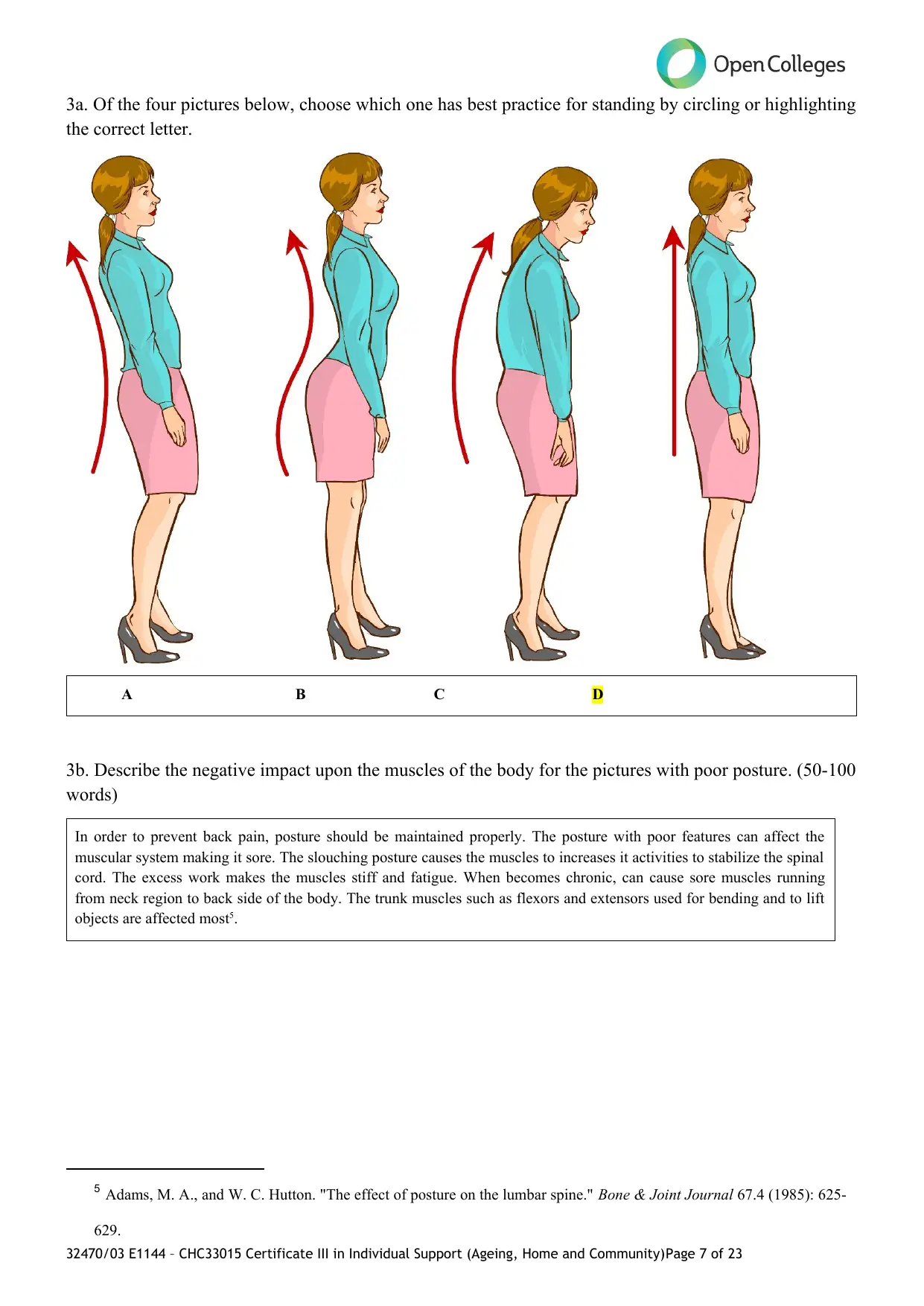
3a. Of the four pictures below, choose which one has best practice for standing by circling or highlighting
the correct letter.
A B C D
3b. Describe the negative impact upon the muscles of the body for the pictures with poor posture. (50-100
words)
In order to prevent back pain, posture should be maintained properly. The posture with poor features can affect the
muscular system making it sore. The slouching posture causes the muscles to increases it activities to stabilize the spinal
cord. The excess work makes the muscles stiff and fatigue. When becomes chronic, can cause sore muscles running
from neck region to back side of the body. The trunk muscles such as flexors and extensors used for bending and to lift
objects are affected most5.
5 Adams, M. A., and W. C. Hutton. "The effect of posture on the lumbar spine." Bone & Joint Journal 67.4 (1985): 625-
629.
32470/03 E1144 – CHC33015 Certificate III in Individual Support (Ageing, Home and Community)Page 7 of 23
the correct letter.
A B C D
3b. Describe the negative impact upon the muscles of the body for the pictures with poor posture. (50-100
words)
In order to prevent back pain, posture should be maintained properly. The posture with poor features can affect the
muscular system making it sore. The slouching posture causes the muscles to increases it activities to stabilize the spinal
cord. The excess work makes the muscles stiff and fatigue. When becomes chronic, can cause sore muscles running
from neck region to back side of the body. The trunk muscles such as flexors and extensors used for bending and to lift
objects are affected most5.
5 Adams, M. A., and W. C. Hutton. "The effect of posture on the lumbar spine." Bone & Joint Journal 67.4 (1985): 625-
629.
32470/03 E1144 – CHC33015 Certificate III in Individual Support (Ageing, Home and Community)Page 7 of 23
Paraphrase This Document
Need a fresh take? Get an instant paraphrase of this document with our AI Paraphraser
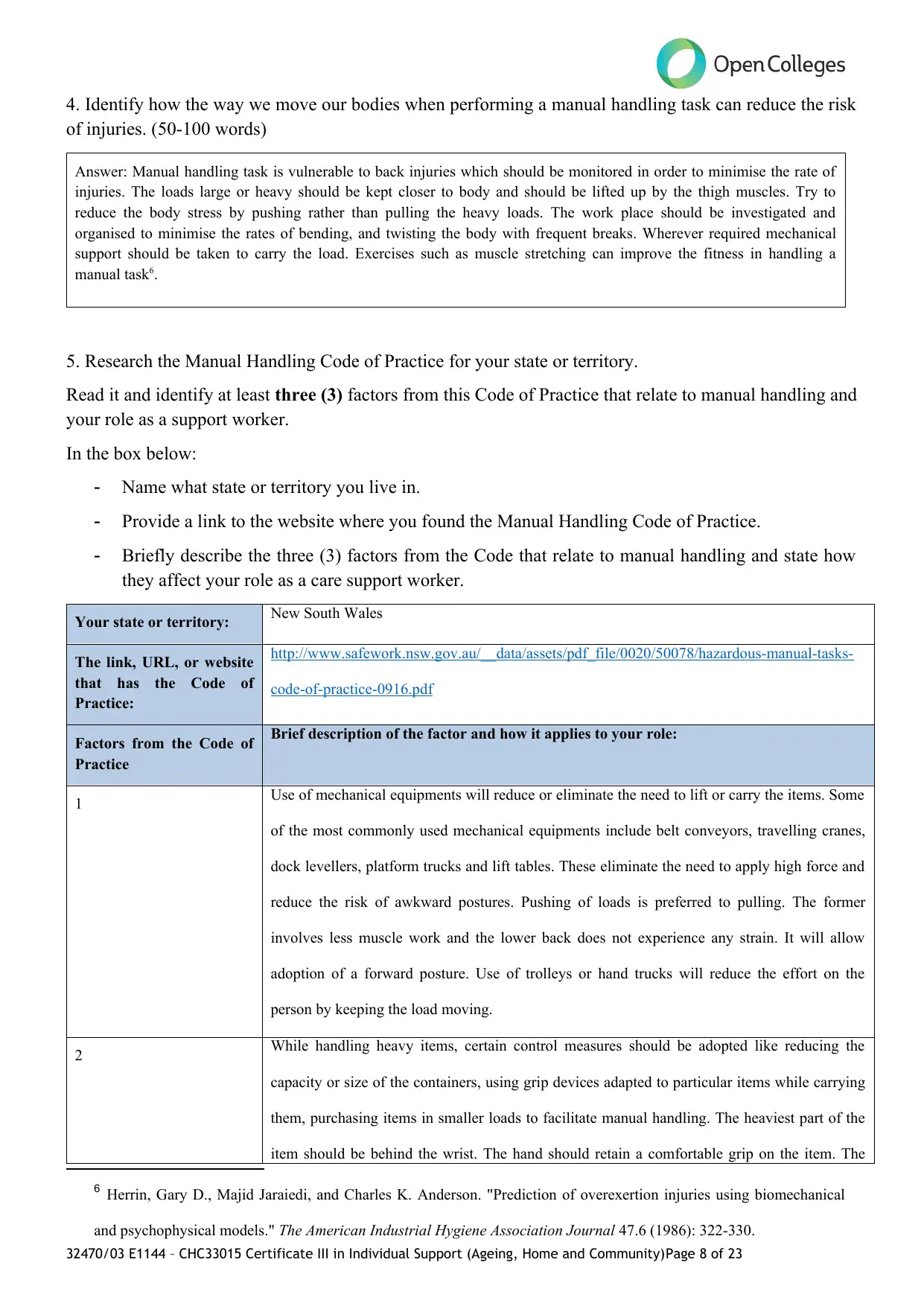
4. Identify how the way we move our bodies when performing a manual handling task can reduce the risk
of injuries. (50-100 words)
Answer: Manual handling task is vulnerable to back injuries which should be monitored in order to minimise the rate of
injuries. The loads large or heavy should be kept closer to body and should be lifted up by the thigh muscles. Try to
reduce the body stress by pushing rather than pulling the heavy loads. The work place should be investigated and
organised to minimise the rates of bending, and twisting the body with frequent breaks. Wherever required mechanical
support should be taken to carry the load. Exercises such as muscle stretching can improve the fitness in handling a
manual task6.
5. Research the Manual Handling Code of Practice for your state or territory.
Read it and identify at least three (3) factors from this Code of Practice that relate to manual handling and
your role as a support worker.
In the box below:
- Name what state or territory you live in.
- Provide a link to the website where you found the Manual Handling Code of Practice.
- Briefly describe the three (3) factors from the Code that relate to manual handling and state how
they affect your role as a care support worker.
Your state or territory: New South Wales
The link, URL, or website
that has the Code of
Practice:
http://www.safework.nsw.gov.au/__data/assets/pdf_file/0020/50078/hazardous-manual-tasks-
code-of-practice-0916.pdf
Factors from the Code of
Practice
Brief description of the factor and how it applies to your role:
1 Use of mechanical equipments will reduce or eliminate the need to lift or carry the items. Some
of the most commonly used mechanical equipments include belt conveyors, travelling cranes,
dock levellers, platform trucks and lift tables. These eliminate the need to apply high force and
reduce the risk of awkward postures. Pushing of loads is preferred to pulling. The former
involves less muscle work and the lower back does not experience any strain. It will allow
adoption of a forward posture. Use of trolleys or hand trucks will reduce the effort on the
person by keeping the load moving.
2 While handling heavy items, certain control measures should be adopted like reducing the
capacity or size of the containers, using grip devices adapted to particular items while carrying
them, purchasing items in smaller loads to facilitate manual handling. The heaviest part of the
item should be behind the wrist. The hand should retain a comfortable grip on the item. The
6 Herrin, Gary D., Majid Jaraiedi, and Charles K. Anderson. "Prediction of overexertion injuries using biomechanical
and psychophysical models." The American Industrial Hygiene Association Journal 47.6 (1986): 322-330.
32470/03 E1144 – CHC33015 Certificate III in Individual Support (Ageing, Home and Community)Page 8 of 23
of injuries. (50-100 words)
Answer: Manual handling task is vulnerable to back injuries which should be monitored in order to minimise the rate of
injuries. The loads large or heavy should be kept closer to body and should be lifted up by the thigh muscles. Try to
reduce the body stress by pushing rather than pulling the heavy loads. The work place should be investigated and
organised to minimise the rates of bending, and twisting the body with frequent breaks. Wherever required mechanical
support should be taken to carry the load. Exercises such as muscle stretching can improve the fitness in handling a
manual task6.
5. Research the Manual Handling Code of Practice for your state or territory.
Read it and identify at least three (3) factors from this Code of Practice that relate to manual handling and
your role as a support worker.
In the box below:
- Name what state or territory you live in.
- Provide a link to the website where you found the Manual Handling Code of Practice.
- Briefly describe the three (3) factors from the Code that relate to manual handling and state how
they affect your role as a care support worker.
Your state or territory: New South Wales
The link, URL, or website
that has the Code of
Practice:
http://www.safework.nsw.gov.au/__data/assets/pdf_file/0020/50078/hazardous-manual-tasks-
code-of-practice-0916.pdf
Factors from the Code of
Practice
Brief description of the factor and how it applies to your role:
1 Use of mechanical equipments will reduce or eliminate the need to lift or carry the items. Some
of the most commonly used mechanical equipments include belt conveyors, travelling cranes,
dock levellers, platform trucks and lift tables. These eliminate the need to apply high force and
reduce the risk of awkward postures. Pushing of loads is preferred to pulling. The former
involves less muscle work and the lower back does not experience any strain. It will allow
adoption of a forward posture. Use of trolleys or hand trucks will reduce the effort on the
person by keeping the load moving.
2 While handling heavy items, certain control measures should be adopted like reducing the
capacity or size of the containers, using grip devices adapted to particular items while carrying
them, purchasing items in smaller loads to facilitate manual handling. The heaviest part of the
item should be behind the wrist. The hand should retain a comfortable grip on the item. The
6 Herrin, Gary D., Majid Jaraiedi, and Charles K. Anderson. "Prediction of overexertion injuries using biomechanical
and psychophysical models." The American Industrial Hygiene Association Journal 47.6 (1986): 322-330.
32470/03 E1144 – CHC33015 Certificate III in Individual Support (Ageing, Home and Community)Page 8 of 23
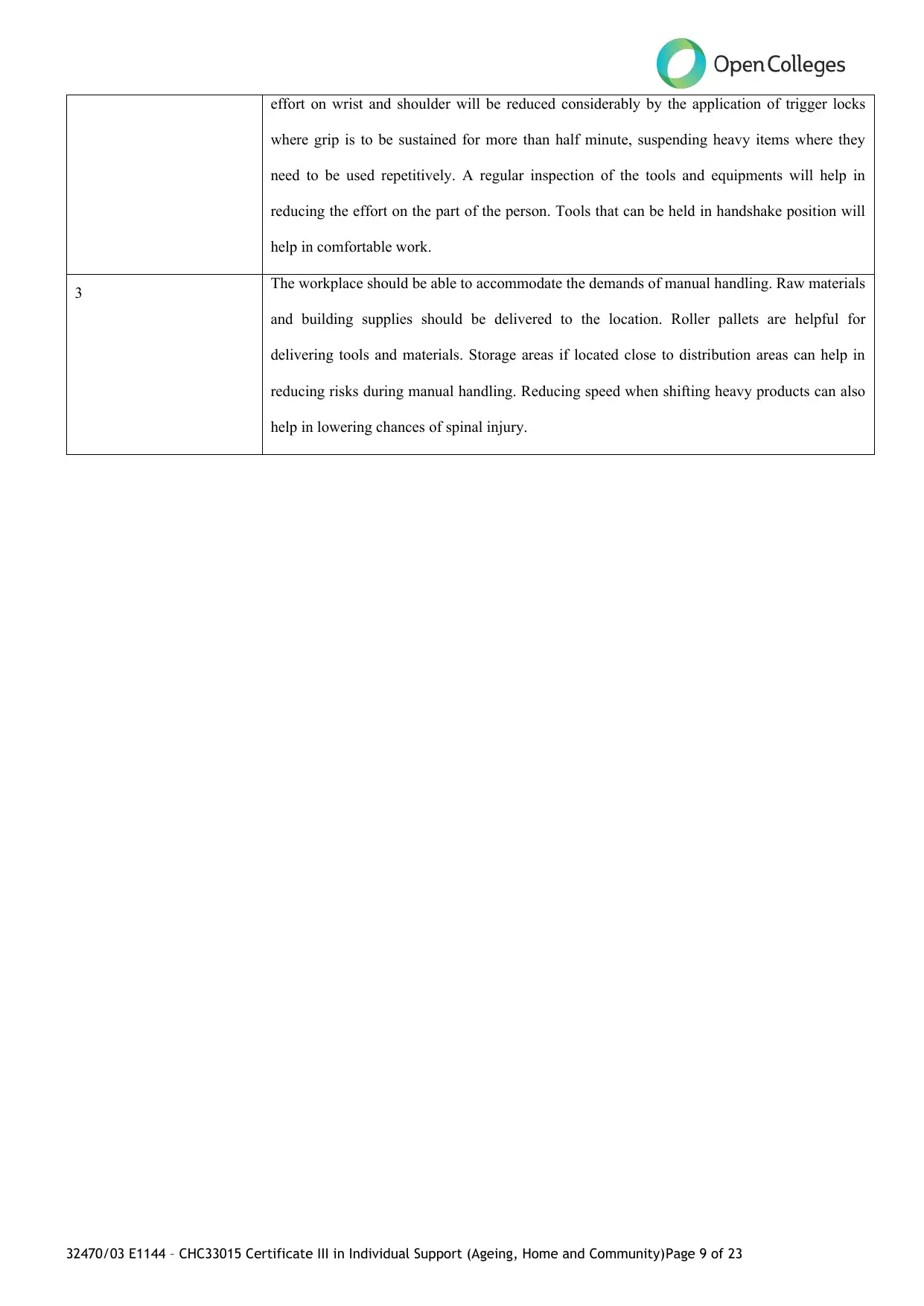
effort on wrist and shoulder will be reduced considerably by the application of trigger locks
where grip is to be sustained for more than half minute, suspending heavy items where they
need to be used repetitively. A regular inspection of the tools and equipments will help in
reducing the effort on the part of the person. Tools that can be held in handshake position will
help in comfortable work.
3 The workplace should be able to accommodate the demands of manual handling. Raw materials
and building supplies should be delivered to the location. Roller pallets are helpful for
delivering tools and materials. Storage areas if located close to distribution areas can help in
reducing risks during manual handling. Reducing speed when shifting heavy products can also
help in lowering chances of spinal injury.
32470/03 E1144 – CHC33015 Certificate III in Individual Support (Ageing, Home and Community)Page 9 of 23
where grip is to be sustained for more than half minute, suspending heavy items where they
need to be used repetitively. A regular inspection of the tools and equipments will help in
reducing the effort on the part of the person. Tools that can be held in handshake position will
help in comfortable work.
3 The workplace should be able to accommodate the demands of manual handling. Raw materials
and building supplies should be delivered to the location. Roller pallets are helpful for
delivering tools and materials. Storage areas if located close to distribution areas can help in
reducing risks during manual handling. Reducing speed when shifting heavy products can also
help in lowering chances of spinal injury.
32470/03 E1144 – CHC33015 Certificate III in Individual Support (Ageing, Home and Community)Page 9 of 23
⊘ This is a preview!⊘
Do you want full access?
Subscribe today to unlock all pages.

Trusted by 1+ million students worldwide
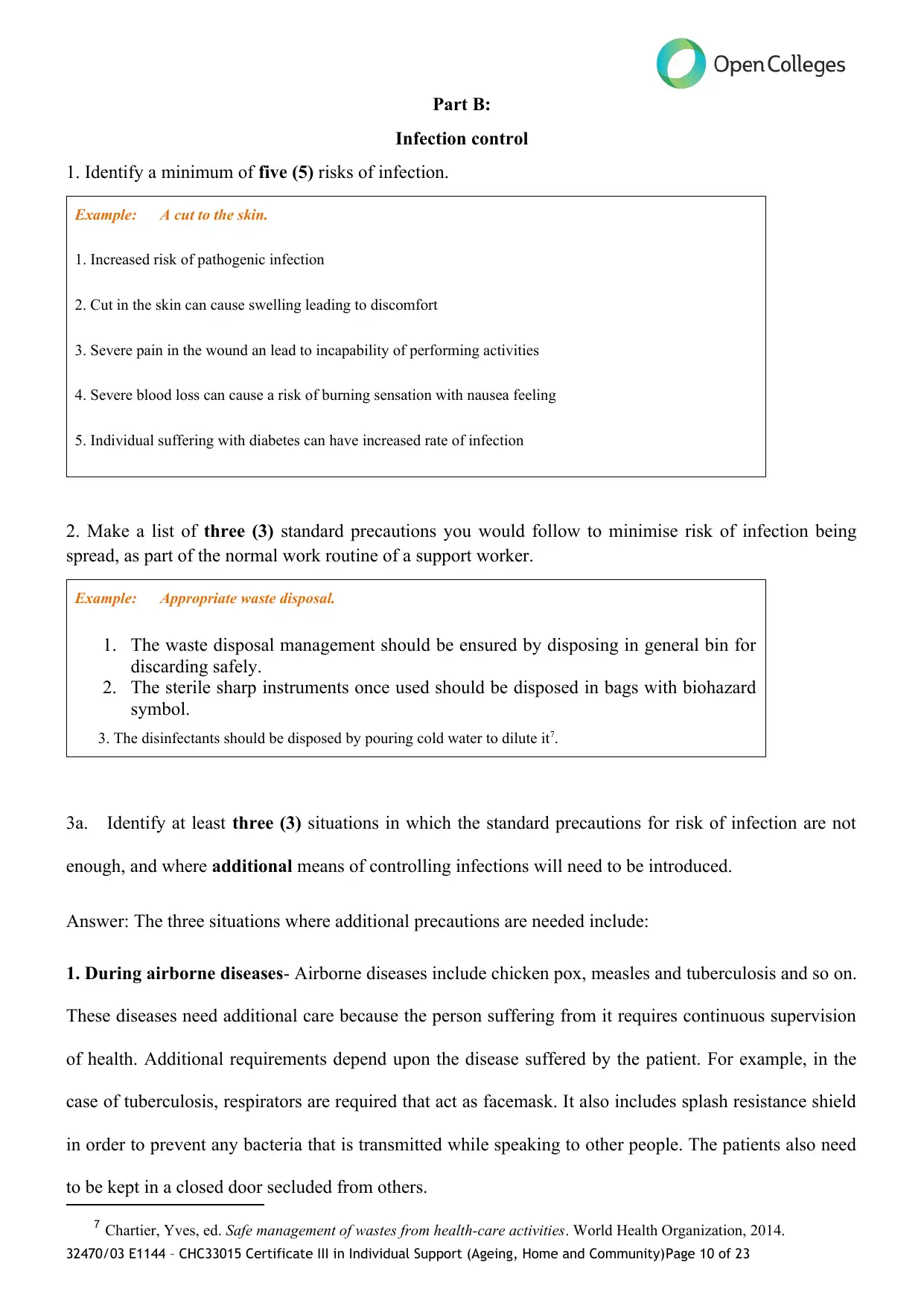
Part B:
Infection control
1. Identify a minimum of five (5) risks of infection.
Example: A cut to the skin.
1. Increased risk of pathogenic infection
2. Cut in the skin can cause swelling leading to discomfort
3. Severe pain in the wound an lead to incapability of performing activities
4. Severe blood loss can cause a risk of burning sensation with nausea feeling
5. Individual suffering with diabetes can have increased rate of infection
2. Make a list of three (3) standard precautions you would follow to minimise risk of infection being
spread, as part of the normal work routine of a support worker.
Example: Appropriate waste disposal.
1. The waste disposal management should be ensured by disposing in general bin for
discarding safely.
2. The sterile sharp instruments once used should be disposed in bags with biohazard
symbol.
3. The disinfectants should be disposed by pouring cold water to dilute it7.
3a. Identify at least three (3) situations in which the standard precautions for risk of infection are not
enough, and where additional means of controlling infections will need to be introduced.
Answer: The three situations where additional precautions are needed include:
1. During airborne diseases- Airborne diseases include chicken pox, measles and tuberculosis and so on.
These diseases need additional care because the person suffering from it requires continuous supervision
of health. Additional requirements depend upon the disease suffered by the patient. For example, in the
case of tuberculosis, respirators are required that act as facemask. It also includes splash resistance shield
in order to prevent any bacteria that is transmitted while speaking to other people. The patients also need
to be kept in a closed door secluded from others.
7 Chartier, Yves, ed. Safe management of wastes from health-care activities. World Health Organization, 2014.
32470/03 E1144 – CHC33015 Certificate III in Individual Support (Ageing, Home and Community)Page 10 of 23
Infection control
1. Identify a minimum of five (5) risks of infection.
Example: A cut to the skin.
1. Increased risk of pathogenic infection
2. Cut in the skin can cause swelling leading to discomfort
3. Severe pain in the wound an lead to incapability of performing activities
4. Severe blood loss can cause a risk of burning sensation with nausea feeling
5. Individual suffering with diabetes can have increased rate of infection
2. Make a list of three (3) standard precautions you would follow to minimise risk of infection being
spread, as part of the normal work routine of a support worker.
Example: Appropriate waste disposal.
1. The waste disposal management should be ensured by disposing in general bin for
discarding safely.
2. The sterile sharp instruments once used should be disposed in bags with biohazard
symbol.
3. The disinfectants should be disposed by pouring cold water to dilute it7.
3a. Identify at least three (3) situations in which the standard precautions for risk of infection are not
enough, and where additional means of controlling infections will need to be introduced.
Answer: The three situations where additional precautions are needed include:
1. During airborne diseases- Airborne diseases include chicken pox, measles and tuberculosis and so on.
These diseases need additional care because the person suffering from it requires continuous supervision
of health. Additional requirements depend upon the disease suffered by the patient. For example, in the
case of tuberculosis, respirators are required that act as facemask. It also includes splash resistance shield
in order to prevent any bacteria that is transmitted while speaking to other people. The patients also need
to be kept in a closed door secluded from others.
7 Chartier, Yves, ed. Safe management of wastes from health-care activities. World Health Organization, 2014.
32470/03 E1144 – CHC33015 Certificate III in Individual Support (Ageing, Home and Community)Page 10 of 23
Paraphrase This Document
Need a fresh take? Get an instant paraphrase of this document with our AI Paraphraser
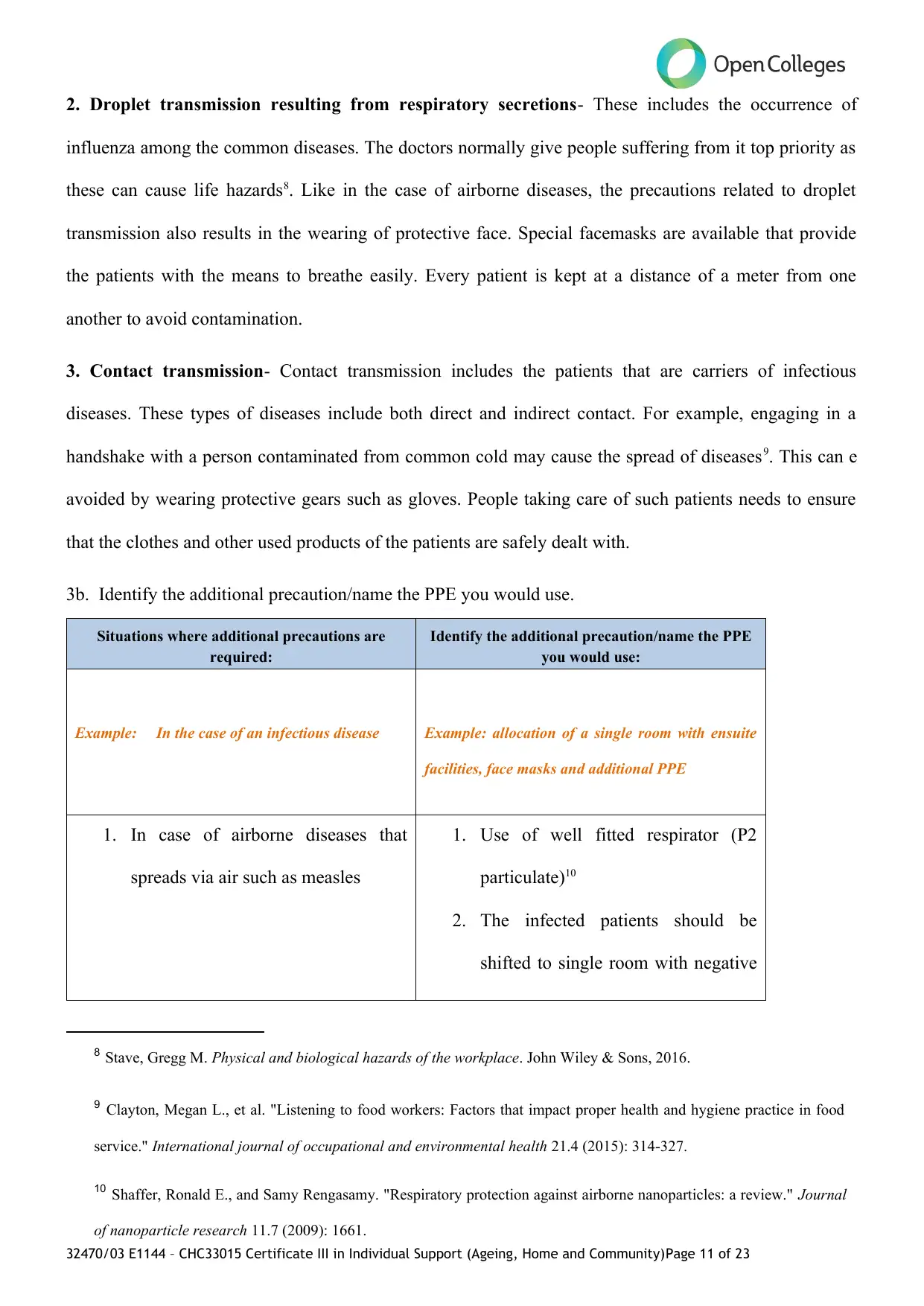
2. Droplet transmission resulting from respiratory secretions- These includes the occurrence of
influenza among the common diseases. The doctors normally give people suffering from it top priority as
these can cause life hazards8. Like in the case of airborne diseases, the precautions related to droplet
transmission also results in the wearing of protective face. Special facemasks are available that provide
the patients with the means to breathe easily. Every patient is kept at a distance of a meter from one
another to avoid contamination.
3. Contact transmission- Contact transmission includes the patients that are carriers of infectious
diseases. These types of diseases include both direct and indirect contact. For example, engaging in a
handshake with a person contaminated from common cold may cause the spread of diseases9. This can e
avoided by wearing protective gears such as gloves. People taking care of such patients needs to ensure
that the clothes and other used products of the patients are safely dealt with.
3b. Identify the additional precaution/name the PPE you would use.
Situations where additional precautions are
required:
Identify the additional precaution/name the PPE
you would use:
Example: In the case of an infectious disease Example: allocation of a single room with ensuite
facilities, face masks and additional PPE
1. In case of airborne diseases that
spreads via air such as measles
1. Use of well fitted respirator (P2
particulate)10
2. The infected patients should be
shifted to single room with negative
8 Stave, Gregg M. Physical and biological hazards of the workplace. John Wiley & Sons, 2016.
9 Clayton, Megan L., et al. "Listening to food workers: Factors that impact proper health and hygiene practice in food
service." International journal of occupational and environmental health 21.4 (2015): 314-327.
10 Shaffer, Ronald E., and Samy Rengasamy. "Respiratory protection against airborne nanoparticles: a review." Journal
of nanoparticle research 11.7 (2009): 1661.
32470/03 E1144 – CHC33015 Certificate III in Individual Support (Ageing, Home and Community)Page 11 of 23
influenza among the common diseases. The doctors normally give people suffering from it top priority as
these can cause life hazards8. Like in the case of airborne diseases, the precautions related to droplet
transmission also results in the wearing of protective face. Special facemasks are available that provide
the patients with the means to breathe easily. Every patient is kept at a distance of a meter from one
another to avoid contamination.
3. Contact transmission- Contact transmission includes the patients that are carriers of infectious
diseases. These types of diseases include both direct and indirect contact. For example, engaging in a
handshake with a person contaminated from common cold may cause the spread of diseases9. This can e
avoided by wearing protective gears such as gloves. People taking care of such patients needs to ensure
that the clothes and other used products of the patients are safely dealt with.
3b. Identify the additional precaution/name the PPE you would use.
Situations where additional precautions are
required:
Identify the additional precaution/name the PPE
you would use:
Example: In the case of an infectious disease Example: allocation of a single room with ensuite
facilities, face masks and additional PPE
1. In case of airborne diseases that
spreads via air such as measles
1. Use of well fitted respirator (P2
particulate)10
2. The infected patients should be
shifted to single room with negative
8 Stave, Gregg M. Physical and biological hazards of the workplace. John Wiley & Sons, 2016.
9 Clayton, Megan L., et al. "Listening to food workers: Factors that impact proper health and hygiene practice in food
service." International journal of occupational and environmental health 21.4 (2015): 314-327.
10 Shaffer, Ronald E., and Samy Rengasamy. "Respiratory protection against airborne nanoparticles: a review." Journal
of nanoparticle research 11.7 (2009): 1661.
32470/03 E1144 – CHC33015 Certificate III in Individual Support (Ageing, Home and Community)Page 11 of 23

pressure during the infection period11
3. The exposed HCWs should be
precluded from direct contact with
the patient from the first exposure
4. Preclusion of the infected HCWs
from the susceptible person for at
least 7 days from the appearance of
rashes12
2. In case of droplet transmission
disease such as Influenza spreading
through respiration
1. The infected patient should be
provided single room13
2. Shifting the patient in cohort in
severe outbreaks especially in case
of children and old aged patients
3. The HCWs who are infected should
be kept away from the patients14
3. Contact based diseases that spreads 1. After starting the required treatment
11 Cepeda, Jorge A., et al. "Isolation of patients in single rooms or cohorts to reduce spread of MRSA in intensive-care
units: prospective two centre study." The Lancet 365.9456 (2005): 295-304.
12 Boyce, John M., and Didier Pittet. "Guideline for hand hygiene in health-care settings: recommendations of the
Healthcare Infection Control Practices Advisory Committee and the HICPAC/SHEA/APIC/IDSA Hand Hygiene Task
Force." American journal of infection control 30.8 (2002): S1-S46.
13 Cepeda, Jorge A., et al. "Isolation of patients in single rooms or cohorts to reduce spread of MRSA in intensive-care
units: prospective two centre study." The Lancet 365.9456 (2005): 295-304.
14 Cepeda, Jorge A., et al. "Isolation of patients in single rooms or cohorts to reduce spread of MRSA in intensive-care
units: prospective two centre study." The Lancet 365.9456 (2005): 295-304.
32470/03 E1144 – CHC33015 Certificate III in Individual Support (Ageing, Home and Community)Page 12 of 23
3. The exposed HCWs should be
precluded from direct contact with
the patient from the first exposure
4. Preclusion of the infected HCWs
from the susceptible person for at
least 7 days from the appearance of
rashes12
2. In case of droplet transmission
disease such as Influenza spreading
through respiration
1. The infected patient should be
provided single room13
2. Shifting the patient in cohort in
severe outbreaks especially in case
of children and old aged patients
3. The HCWs who are infected should
be kept away from the patients14
3. Contact based diseases that spreads 1. After starting the required treatment
11 Cepeda, Jorge A., et al. "Isolation of patients in single rooms or cohorts to reduce spread of MRSA in intensive-care
units: prospective two centre study." The Lancet 365.9456 (2005): 295-304.
12 Boyce, John M., and Didier Pittet. "Guideline for hand hygiene in health-care settings: recommendations of the
Healthcare Infection Control Practices Advisory Committee and the HICPAC/SHEA/APIC/IDSA Hand Hygiene Task
Force." American journal of infection control 30.8 (2002): S1-S46.
13 Cepeda, Jorge A., et al. "Isolation of patients in single rooms or cohorts to reduce spread of MRSA in intensive-care
units: prospective two centre study." The Lancet 365.9456 (2005): 295-304.
14 Cepeda, Jorge A., et al. "Isolation of patients in single rooms or cohorts to reduce spread of MRSA in intensive-care
units: prospective two centre study." The Lancet 365.9456 (2005): 295-304.
32470/03 E1144 – CHC33015 Certificate III in Individual Support (Ageing, Home and Community)Page 12 of 23
⊘ This is a preview!⊘
Do you want full access?
Subscribe today to unlock all pages.

Trusted by 1+ million students worldwide
1 out of 21
Related Documents
Your All-in-One AI-Powered Toolkit for Academic Success.
+13062052269
info@desklib.com
Available 24*7 on WhatsApp / Email
![[object Object]](/_next/static/media/star-bottom.7253800d.svg)
Unlock your academic potential
Copyright © 2020–2025 A2Z Services. All Rights Reserved. Developed and managed by ZUCOL.





